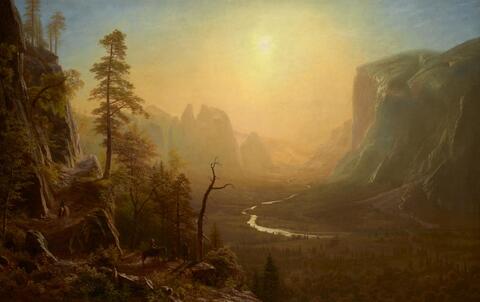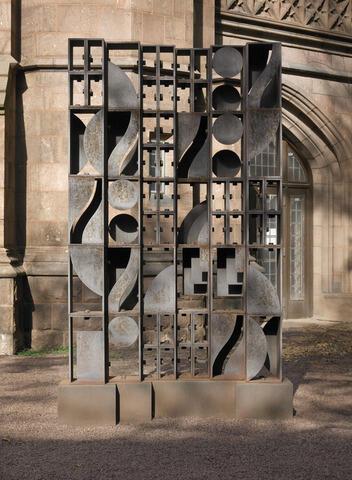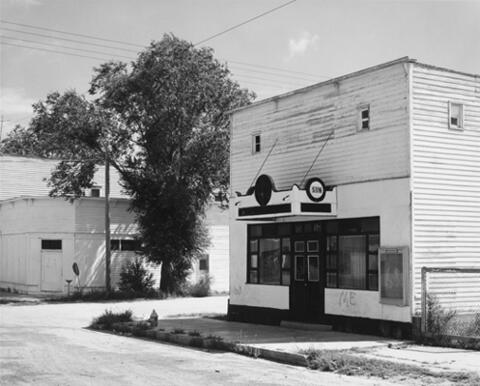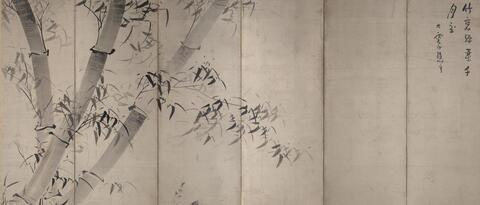The Yale University Art Gallery houses a significant and encyclopedic collection of art within Yale’s campus. Their collections encourage appreciation and understanding of art and its role in society through direct engagement with original works of art. The Gallery stimulates active learning about art and the creative process through research, teaching, and dialogue among communities of Yale students, faculty, artists, scholars, alumni, and the wider public.
For an introduction to the YUAG’s works, explore the gallery’s Collection Highlights.
Sample environmental humanities collections include:
Hudson River School Paintings
The Gallery holds one of the preeminent collections of nineteenth-century American landscape paintings by artists connected to the Hudson River School, including Albert Bierstadt, Frederic Edwin Church, Jasper Francis Cropsey, Asher B. Durand, Sanford Robinson Gifford, Martin Johnson Heade, John Frederick Kensett, and others. Images of landscape and ideas of nation are deeply intertwined in works like Bierstadt’s Yosemite Valley, Glacier Point Trail (ca. 1873), which helped to shape and articulate American identity in the mid-nineteenth century.
Albert Bierstadt, Yosemite Valley, Glacier Point Trail, ca. 1873
The Furniture Study
A unique campus asset, the Gallery’s Furniture Study is a working library of more than 1,100 examples of furniture and wooden objects ranging in date from the 17th to the 21st century. As a subset of the Gallery’s distinguished collection of American decorative arts, the Furniture Study tells a global story about the circulation and transformation of raw materials into functional objects that express the taste and cultural milieu of their makers and owners. From September 2019, the Furniture Study is in its new home, a purpose-built space in the Collection Studies Center at Yale West Campus.
The American Decorative Arts Furniture Study
Isithebe (Zulu food mats)
Included in the Gallery’s collection of over 2,000 objects from Africa are a group of 191 Zulu mats (Isithebe) dating from the 1960s through the early 1990s. These mats, which are used for dining, are woven from various wetland grasses and reeds, either salt marsh rush (incema) or finely ribbed rushes (imizi). Imizi seldom grow more than 30 cm tall, and so the dimensions of the mat reflect that plant that was used. The tradition of making Isithebe continues today, and recent studies have highlighted how crafters sustainably manage the local wetland resources in their creation.
Titian Ramsay Peale’s Sketchbooks
The Gallery The youngest son of Philadelphia-based artist and naturalist Charles Willson Peale, Titian Ramsay Peale served as a scientific illustrator on several U.S. survey expeditions. The Gallery’s Prints and Drawings collection includes five bound sketchbooks that Peale created from 1819–20 on Stephen Harriman Long’s expedition to the Rocky Mountains, on which he served as an assistant to the trip’s official naturalist Thomas Say. The sketchbooks contain over 200 original pencil and watercolor sketches.
Titian Ramsay Peale sketchbooks
Ancient Coins
The Gallery’s numismatic collection, which includes more than 120,000 coins, medals, and related objects, is by far the largest and most diverse of its kind held by an American university. To the extent that coinage is closely tied to economic productivity and circulation, the collection and its embedded histories offer indirect insights into the environmental impacts of human activity across time. Coins from the ancient world offer insights into the early history of mining and resource extraction, global commerce, and industrial production. Recent analysis of lead isotopes in ice core samples, which track economic productivity in the ancient world, are directly tied to coin production.
George Catlin Lithographs
The Gallery has over 50 hand-colored lithographs produced by George Catlin, many which are drawn from Catlin’s North American Indian Portfolio: Hunting Scenes and Amusements of the Rocky Mountains and Prairies of America (1844). Starting in the 1830s, Catlin traveled widely throughout the North American Plains to illustrate Native Americans tribes. Catlin’s prints depict Indigenous communities and native landscapes that would soon undergo dramatic transformation in the name of manifest destiny by European settlers.
David Goldblatt Photographs
From 1948 through his death in 2018, South African photographer David Goldblatt documented his native country. While Goldblatt is not explicitly an environmental photographer, many of his series speak to the ways that the country’s politics during the Apartheid era and beyond have shaped the land and the lives of the people that live within in. The Gallery holds a key set of Goldblatt’s prints along with three handmade maquettes for early projects, including On the Mines (1973), which examines gold mining industry starting in the mid-1960s, as it was entering a period of decline.
Louis Nevelson, Atmosphere and Environment XI (Designed 1969, Fabricrated 1971)
Nevelson’s large steel composition is one of many outdoor sculptures that interact with the terraces and green spaces connected to the Gallery. The work forms a wall of abstract geometric forms and voids that change in appearance as sunlight and shadows shift across its surfaces. The structure is designed to weather over time, forming a rich surface patina in response to the surrounding environment. The work is avaliable to see in the Sculpture Gallery.
El Anatsui, Society Woman’s Cloth (Gold) (2006)
Ghanaian artist El Anatsui’s transforms found objects, in this case discarded bottle caps, into sprawling, shimmering tapestries. The work combines references to traditional arts of Nigeria, where he was based for most of his career, with a postmodern sensibility. His creative use of waste draws attention to contemporary environmental issues surrounding consumption, recycling, and the environment, while connecting them to the history of colonialism in West Africa.
Ike Taiga, Moonlight Bamboo (ca. 1758–60)
The Gallery’s Asian art collection has sizeable collection of hanging scrolls and screens featuring landscapes and other natural motifs dating from the 10th century through the present. Taiga, a celebrated Japanese literati artist, paints gigantic bamboo trunks, embellished with clusters of leaves rustling in a light breeze. Though there is no moon in the composition, bamboo leaves in light ink evoke the illumination of the moon. The composition exudes a deeply felt reverence for natural forms and the contemplative states they inspire.
Robert Adams Photographs
Over the past five decades, Robert Adams has photographed the changing landscape of the American West, engaging with a fragile beauty that endures despite our troubled relationship with nature, and with ourselves. The Gallery holds master sets of each of the photographer’s major series, numbering over 2,000 prints. His photographs, which document a landscape increasingly overtaken by suburban sprawl and the byproducts of industrial development, provide a modern counterpoint to the Romantic depiction of the West found in the landscapes of the Hudson River School painters and nineteenth-century photographers like Carleton Watkins and Eadweard Muybridge.
The Place We Live (web exhibit)





